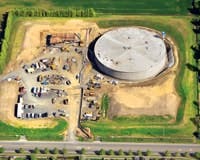Hillsboro Water, located approximately 15 miles west of Portland in the city of Hillsboro, Ore., serves nearly 80,000 customers. The service area includes customers residing in the city’s municipal territory, more than 600 rural connections in Washington County and wholesale service to three water utilities.
Following a lengthy site selection process, the city began construction of the 10-million-gal Will Crandall Reservoir and Pump Station in March 2012. Once constructed, the reservoir will help Hillsboro meet its required in-town potable water storage of three average days’ emergency demand. The new reservoir will be Hillsboro’s third in-town reservoir and will increase the city’s total storage capacity to approximately 30.6 million gal.
Project Delivery Challenges
The Will Crandall project includes many challenges that the city has resolved by working with an experienced design team. The city of Hillsboro selected CH2M Hill to help locate and purchase a site for the facility, as well as provide engineering design and construction services. During the development of the project, CH2M Hill and the city opted for an alternative project construction method known as the construction management/general contractor (CM/GC) approach for project delivery. This approach often is beneficial for large, complex projects such as the Will Crandall Reservoir and Pump Station, because it engages the construction contractor early, during design.
The city reviewed proposals for CM/GC services and ultimately selected Ward-Henshaw Construction. The CM/GC approach brought Ward-Henshaw Construction into the project early in the design phase, allowing it to assist in the development of the project. The company was able to assist in the scheduling and phasing of construction, analyzing constructability issues, providing cost estimates to the team and presenting engineering options.
Because the reservoir is classified by the building code as an essential facility, it is of utmost importance that the reservoir and pump station are able to withstand a seismic event. Geotechnical studies indicate that a probable earthquake could cause liquefaction of the soils at the project site. Therefore, strengthening of the ground beneath the project was the first challenge to overcome. Together, the city, CH2M Hill and Ward-Henshaw Construction determined that cement deep soil mixing (CDSM) was the soil improvement option with the lowest impact on the community. Raito Inc. was selected as the subcontractor to perform the deep soil mixing. It used an auger to inject and mix cement into the existing soils in a grid underlying the reservoir, pipeline and pump station. This process increased the stability and bearing capacity of the soils beneath the reservoir and reduced the potential of subsidence due to liquefaction.
To best address the concern for reservoir seismic performance, a prestressed concrete reservoir was selected and currently is being constructed by Ward-Henshaw Construction. Concrete offered a combination of the highest quality, most economical and lowest maintenance solution for the reservoir. The reservoir will include specialized seismic connections at the wall base and wall top, allowing for a free connection and ductility of the structure during a seismic event. Additionally, the reservoir walls will be compressed both vertically and circumferentially to keep the concrete in its most efficient state and to give the structure strength and durability over its service life. The specialized prestressing will be performed by DN Tanks, using a strandwrapping machine that will tension galvanized 7-wire strand to 14,950 lb. Through the wrapping process, the prestressing will be recorded and electronically monitored continuously, ensuring that a tight tolerance of the applied force will be maintained. The prestressed reservoir will ensure that the project is economical and the structure has the highest level of strength and durability to undergo horizontal and vertical ground accelerations due to a seismic event.
Energy Savings & Water Quality
Although the primary function of the reservoir is to provide potable water supply to the city of Hillsboro’s customers, the city also is participating in the local power utility’s Dispatchable Standby Generation (DSG) program with Portland General Electric (PGE). The pump station adjoining the reservoir requires standby power in the event of power loss to the site. Because the standby power system is for emergency purposes and rarely used, placing this asset into the DSG program and allowing PGE to put power back into the utility’s grid during peak demand periods seemed logical and feasible. As part of the DSG program, PGE will pay for generator fuel, all maintenance, monthly online testing and specialized equipment, and will provide the city with an annual stipend for regulatory costs.
The 3,500-sq-ft pump station also will house a water-driven turbine-generator and a secondary pilot-operated, pressure-reducing flow control valve (FCV) to fill the reservoir. The water main servicing the reservoir operates at 130 psi, which must be reduced before the water enters the reservoir. While filling the reservoir, excess pressure will be converted into electricity through the hydro-turbine system, and the power generated will be credited to the city’s electric bill in a net-metering arrangement. The FCV provides a backup means to fill the tank if necessary. The reservoir project also has been designed for future onsite solar power generation, reserving the area atop the reservoir, as well as a portion of the ground area, for additional power generation.
The city also will reduce energy consumption by using a unique operational scheme. As opposed to its current operations, in which the reservoirs fill during a three-day period and then are immediately pumped into the distribution system, the city of Hillsboro is anticipating to store the water in the reservoir for up to 30 days between fill and draw cycles. Water quality will be maintained with a pumped mixing system and rechlorination. The planned energy savings associated with reduced pumping qualified the city for Energy Trust of Oregon grant money, which helped fund the mixing and rechlorination systems.
Storing the water for these extended times means that water quality degradation is a concern. As a result, the city will have 12 unique sampling points: four locations at three different elevations within the reservoir. The sampling points will allow the city to closely and continuously monitor the water quality in the reservoir. All testing will be performed in a consolidated sampling location within the pump house.
Public Outreach & Sensitivity
With the challenges of the project, public outreach and communication has been critical. One of the benefits of the CM/GC approach was that the contractor was given the opportunity to assist in developing a community disruption mitigation plan, which was vital to maintaining good community relations.
Several additional steps also were taken to minimize the impact to the community. CDSM was selected as the foundation system, as this type of installation is quieter than hammered piles and less costly than drilled piers. Noise and visual impact have been reduced by berms that were built from the native soil, which in turn eliminated the need for trucks to haul the material to another location.
The city also has hosted site visits for local groups, neighbors and schools in an effort to educate the community on the project and why the facility is essential to the community.
The Will Crandall Reservoir and Pump Station will be completed in the fall of 2013. With the combined efforts of the design and construction team the city of Hillsboro selected, the project will meet current water quality and design standards and will offer safe, reliable potable water to the city’s customers.
Download: Here



